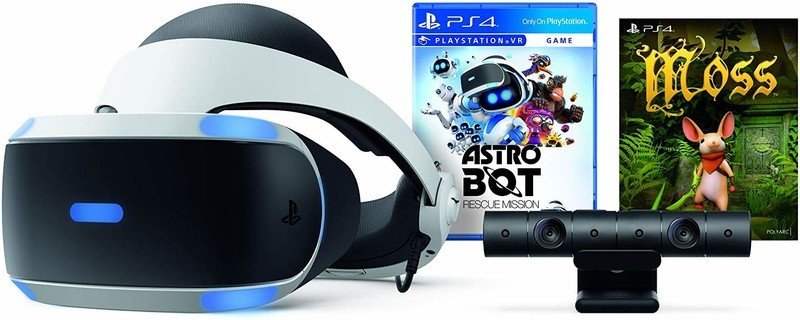Everything I would do to improve the PlayStation VR for the PlayStation 5

Currently, my only room scale VR is the PlayStation VR and I really enjoy it. The price point and the availability of the hardware to run it make it an excellent choice for anyone who wants to start their VR journey. After all, 40 million people already have a PS4, and with the PSVR being as low as $199 in some sales you can see why 4 million people have made the leap.
While the PSVR is an excellent entry point to VR, its age is starting to show. With devices like the Oculus Quest offering untethered VR for an excellent price, the new PSVR will need to up its game to compete. Thankfully we have news of the new PlayStation 5 and from everything we know so far it is going to be a VR powerhouse.

Room scale VR at a low price.
The PlayStation VR is one of the easiest ways to get into the VR with a large library of games and a low price point. If you own a PlayStation 4 then you should probably own this too.
What's new with PSVR?
Updated April 24, 2019: New PSVR patent

The eagle-eyed team over at Inverse noticed that new patents have been placed for a new VR headset from Sony. From the look of the diagrams, and the wording on the patent it seems likely that this would be the PSVR 2 that we are hoping to see.
Highlights of the patent include integrated headphones, a bump in resolution for the screen, and the best bit, it could be wireless! The wireless information in the patent is extremely technical but essentially the PS5 would use high-frequency radio waves to transmit large packets of data — over the 60GHZ range — directly to the headset, removing the need for wires altogether.
The patent says that the battery in the headset could last 5 hours at a time, which should be more than enough for any normal user, and run at 120Hz, which would reduce the risk of nausea. HAving a truly wireless experience for PSVR would be amazing and would help keep the PSVR on the top of the VR food chain.
The real question is, can Sony produce such a thing, and still keep it a low enough price point to make people want to buy it?
Be an expert in 5 minutes
Get the latest news from Android Central, your trusted companion in the world of Android
Updated April 16, 2019: PlayStation 5 spec sheet released
"I won't go into the details of our VR strategy today," he says, "beyond saying that VR is very important to us and that the current PSVR headset is compatible with the new console." — Mark Cerny
We are finally starting to hear about Sony's follow-up to the PlayStation 4. We don't know its name so I will call it the PlayStation 5, but we do know a lot about it that directly impacts PSVR and how Sony can improve it.
In a recent interview with Wired, Mark Cerny — the lead system architect for the PlayStation 5 — said that the PlayStation 5 will be compatible with this generation of the PSVR.
This is both good and bad, as it suggests the PSVR 2 won't release alongside the PS5. He also states that the PS5 will feature backward compatibility with the PS4, so hopefully we may be able to use our current PSVR library on the new console.
Graphical Fidelity

Currently, even using the PS4 Pro, the graphical resolution on the PlayStation VR is poor. While most games have been tuned to account for the lower processing power some games, Monster of the Deep for example, show the graphics to be mediocre at best.
The PlayStation 5 spec sheet has it running a processor based on the Ryzen 8-core chipset, as well as a Radeon Navi GPU. That kind of firepower feels custom made to run a PSVR at a graphical fidelity we can be proud of.
Increasing the resolution inside the headset would instantly make the games more enjoyable, reduce eye strain, and sharpen the graphical quality considerably. Where the Rift and Vive use one screen per eye, each with a resolution of 1080 x 1200 pixels, the PSVR only has a single screen at 1080 x 960, and you can feel the difference. The PSVR will need to push the resolution up if it wants to compete in a room scale world.
With better screens being made almost daily and Sony having a screen division, this shouldn't be too difficult for them to accomplish and will go a long way to making the PSVR 2.0 a contender.
More: Try these great games for PlayStation VR for under $20
Processing Power

One of the biggest problems Sony has is the lack of processing power available in the PS4 or even the PS4 Pro. Without sufficient CPU or GPU power, the PlayStation VR will always lag behind. Happily, we know the PS5 is going to have the processing power we need to push the PSVR 2 well beyond the scope of the original.
The new specs from the PS5 (it's going to be an 8 core processing machine!) will remove the need for any external boxes — my original idea was to have an external GPU in the sync box — allowing all the legwork to be done by the PlayStation 5 itself. This will allow the headset to be improved in every way, and the new Solid State Drive Sony is going to be using will reduce problems like rendering scenes on-the-fly, and loading screens, that really break the immersion in VR.
Audio
Mark Cerny seems to take his audio very seriously. The new processor in the PlayStation 5 has a specific unit, dedicated to "3D audio" to help players become immersed in their games. This sounds like it is built with VR in mind. The best way to experience 3D audio would be in a truly 3D environment like the PSVR.
The new PSVR will need to push this new system to its limit and give us the hardware to back it up. The headphones that come with this generation of PSVR are serviceable, but they will need to be much better if they are to take advantage of this new audio excellence from the PS5.
Another huge advantage of having the audio system built in is the complete removal of the current sync box. The sync box helps to keep the PlayStation 4, the PSVR, and your TV synced in terms of the spatial audio, so the arrival of a dedicated 3D audio chipset should make the sync box obsolete. The PS5 with PSVR will be just two devices without the need for a third, cluttering up your space.
360 Coverage

The biggest advantage that the Rifts and Vives of this world have is 360-degree tracking. Because they have light gates in up to four corners of the room they can create a much more immersive arena than the PSVR allows. When playing my PSVR games I stand with my legs touching my sofa behind me, after all, there is no need to have space behind me, I have no way to turn 360 only 180. This means in games such as Farpoint, Doom and even Rec Room you are unable to react as fast as people on other platforms having to use a button to spin you, creating a disconnect from the game world and sometimes, nausea.
For PSVR 2.0 Sony could fix this one of two ways, either light gates like Rift/Vive or, perhaps, take a leaf out of Windows Mixed Reality's book and make the PSVR inside out tracking. Inside out would mean removing the PlayStation Camera and adding cameras to the PSVR headset itself. Of course, that would mean having far better controllers than we currently have.
More: How to locate and fix tracking issues for your PlayStation VR
New Controllers

Every issue I have highlighted here pales into insignificance against the mess that is the Move Controller. Originally made as a quick fix to the "Wii Problem" the Move Controllers are basic to the point of being unusable. Lacking any kind of thumbstick or even basic D-Pad, the Move Controllers are woefully underprepared for the intricacies of the VR World. Don't get me wrong, as far as basic controls go the Move sticks work, they just don't allow you to truly explore your world.
With games like Rec Room and Sparc requiring you to have more control of the motion of your hands and more accuracy in your movements the Move Controllers need a huge overhaul if they are to be used in PlayStation VR 2.0, from the shape of the wand to the placement of the buttons, everything needs to be remade. The latest iteration of the Move Controllers did nothing to fix any of the issues except one, they gave it a micro USB instead of a mini USB. Great.
If Sony were to only deal with one thing, let it be this. Please improve the Move Controllers. Everything else in this article is a wish list really, things I would love to see to elevate the PlayStation VR to new heights, but the upgrade to the Move Controllers is a must.
With Crossplay becoming the norm in VR we must have parity in the control systems. The graphical fidelity is not really a block to competing across platforms, games like Rec Room barely think about resolutions and the like, but not being to aim or move as quickly as someone in a Vive is, and will remain so until the Move Controllers are fixed.

PlayStation Move controllers ($95 at Amazon)
The PlayStation Move controllers are the best way to use your PSVR right now. They make any game feel more immersive and enjoyable!
Conclusion
With all this information about the PlayStation 5 surfacing, I am even more excited for the future of the PlayStation VR. With 3D audio built in, masses of processing power, and a whole new graphics chipset — seriously, these specs are intense — the PS5 looks like it could contend with any VR ready PC. Sony has the opportunity to make the PSVR 2 something special, and I am here for all of it.
But Sony, please fix those damn controllers.

